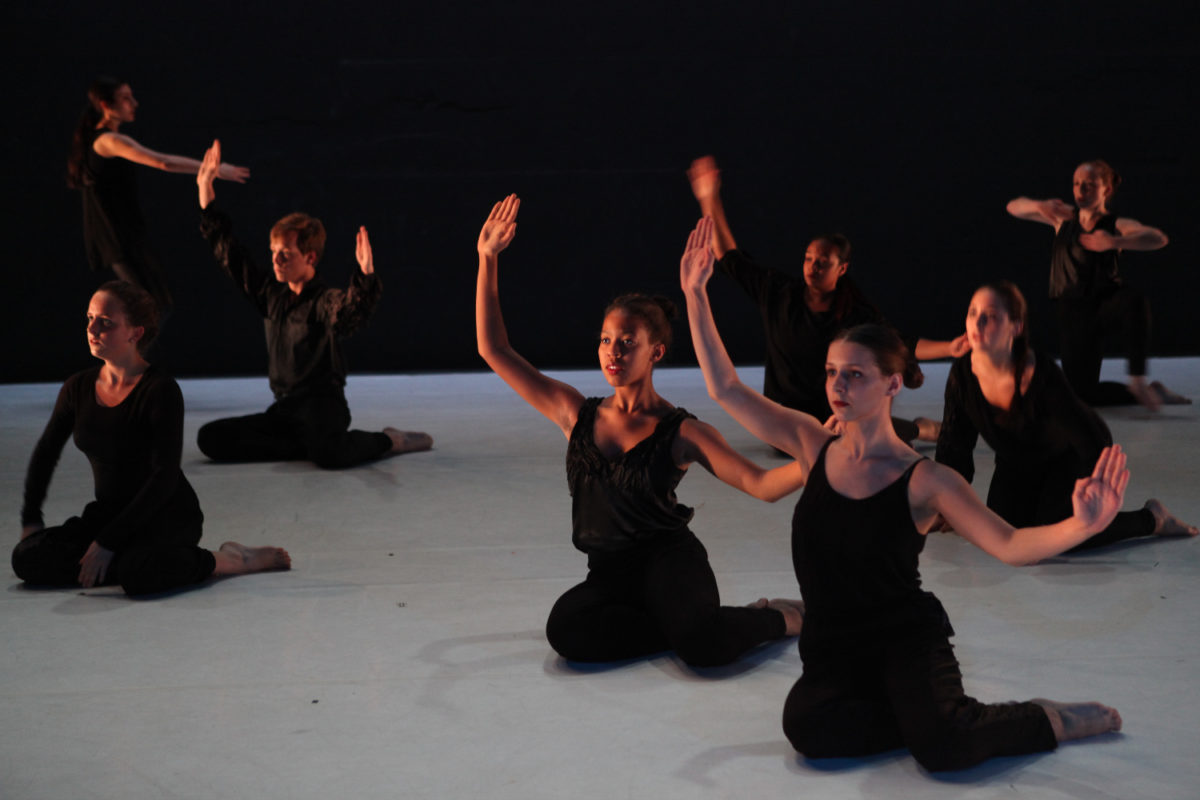A conversation with dancers Xiomara Bovell and Maggie Weirich

There are few art forms that exude classicism and ancien régime more than ballet. In actuality, nothing embodies better the dynamism, fluidity, and potential of the human spirit. This conversation was held digitally over Zoom in December 2020, two months after the four of us had performed together in “Can You Hear Me,” a clandestine performance in San Francisco’s Golden Gate Park scripted and directed by Luna Izpisua Rodriguez. While our shared interest in encouraging the individualism of performers and expanding multidisciplinary creativity across the performing arts came together during the show, the conversations that probe the traditions of classical dance have continued. This conversation was condensed and edited for clarity.
PC/LIR: Let’s start with some of the values and traditions in ballet that you encountered in your training.
MW: Well Xi went to conservatory for dance, right? Which is sort of the establishment for “traditional.” But America… not America, but the schools that we have are a little bit different…. The values my teachers taught me, it’s all about manners and being respectful, things like that.
XB: There’s two parts. When I started doing an associates program, they gave us a rulebook. You don’t drink water unless you’re told to drink water. You couldn’t take your bottle until you’re told. You always thank the musician who plays for you—you call them maestro, never by their name. These kinds of things. You don’t talk in class, you don’t fiddle. It’s funny because going to the ballet program was very formal, you have to wear your uniform properly, you’re told you don’t wear accessories, nothing. But when I started the contemporary program, people were wearing their hair down, track suits, black tights over their leotards, there was less etiquette involved.
MW: I think it’s the mentality around dancing. When your mom signs you up for ballet over here, it’s an extracurricular, or it’s “I want your posture to be better.”… There’s less knowledge of ballet as an art form. Each level had a different colored leotard. Every little girl looked the exact same. Hands at the bar, doing the same thing. Little kids peed themselves because they didn’t want to ask to go to the bathroom. It was so proper. All these kids were crying because their moms were pulling their hair back tight.
When you came to the United States, Xi, did you feel like there was a difference in ballet?
XB: Everything was very “Balanchine,” which I’d never done before. I grew up doing RAD, or “Royal Academy of Dance,” which is the English style, everything is very set and linear. It’s all about the continuation of the line and working from the foundational port de bras positions. You never bend the hands. But Balanchine is very like this, [Xi very expressively raises her left arm up and her right arm goes out to the side with her fingers spread and a bent wrist, very angular] so that was very different to get used to.
What part of ballet culture do you love?
XB: It’s so beautiful and it feels so beautiful to dance. When I do ballet, or when it’s going nicely—because sometimes you have a day where you feel like “ugh I hate it, I can’t do it right,”—but when you get those days where everything feels good, you feel so graceful, elegant, light as air.
MW: All of that structure creates really dedicated and determined people. You are submersed in it. You are living in that moment. All of that control outside you are learning to do inside your own body. You go into class and you know where everything is in your body and you can execute steps well. I don’t think it’s necessary to have that environment in order to create that, because it’s like what Xi said, it’s your body moving. Ballet is the foundation, that structure that you can break at a certain point and play with.
XB: It goes into everything you do.
Do you feel what you do is removed from the everyday, like street or club dancing? Do you find a connection between what you do onstage with what you do offstage?
XB: We had this conversation in college, but with regards to music. The way that classical genres are seen as legit because they are taught in a school environment, … the reason why hip hop wasn’t taught in class is because the people who created hip hop were not legitimized by mainstream society. I think the same of dance. It’s changing now, hip hop and contemporary dance—things like vogueing—are now sort of in the mainstream and people want to teach them and bring them into conversatories as part of the training. For a long time, it was movies like Save the Last Dance, the ballet girls in the studio meet some boys at the club and do a fusion kind of thing, and it was this imbalance of privilege. But they are not dissimilar and they take equal levels of skill, knowledge and refinement to be done well. … The way dance is taught, ballet is your foundation and everything else comes out of that. Anything that is non-Western tradition is supplementary, is exotic—take a couple of classes for fun, see how you feel about it.

Interesting about the term exotic. You’ll take a Flamenco, or a West African dance class, and it’s like these sprinkles on top.
XB: There’s this style in contemporary dance, the Dunham technique. A Black ballet dancer [Katherine Dunham] took contemporary and spent a lot of time in the French Caribbean, and some of the nations in Africa, and made a new style. She set out to decentralize what was thought of as the core of modern/contemporary dance at the time.
You have to actively educate the audience on what they are looking at. You can’t feed them the same things just because they like it. I think that’s what an art form does, it tests your boundaries and your imagination. You don’t have to like it all the time.
How do you feel ballet could decentralize things now? What changes do you think are being made to maintain an audience or to simply get with it?
MW: Ballet is slow to evolve. It is deeply rooted in old traditions and is keeping alive the classical ballet that we’ve been doing for centuries. It came from court dancing, and that is still so present and highbrow. I do think our generation is turned off by it. I am turned off by that, myself. You are brought into this studio at a young age and literally put into a bubble. This world becomes a bubble. And you stay in that bubble. … Trying to decentralize it? We are doing that. Classical ballet isn’t, but all of these iterations of dance do it slowly, contemporary, modern, all these different styles are doing it, pushing the boundaries of the foundations that they are so rooted in.
XB: The theaters have a role in it as well. There’s a place called Sadler’s Well in London. They have always been so prog, welcoming so many styles. I feel like they make sure that what is presented on the program is reflective of the country, the population. They were the ones that put on Akram Khan, the choreographer who mixes Bangladeshi dance with contemporary, and since the beginning of his career, they’ve supported him. Now he’s massive, he works with the English National Ballet, and so many companies.
What has to change to make ballet more accessible?
MW: I think it goes back to what Xi was saying about giving the audience a taste of everything. You have to actively educate the audience on what they are looking at. You can’t feed them the same things just because they like it. I think that’s what an art form does, it tests your boundaries and your imagination. You don’t have to like it all the time.
XB: I feel like pricing is a thing. In London you can get student tickets or last minute tickets. You can pay 10 pounds and go see a show after class. And so… if you didn’t like it, you could just say, “oh well I only spent 10, 15 pounds, it’s okay.” Take Zellerbach Hall [UC Berkeley’s performing arts center], they have really great programming, probably my favorite in Northern California, but it’s so expensive. At least $50 at a time. Either you know who is dancing or, if you are looking to dabble, you might not want to spend that.
MW: I think it’s really daunting to go into an opera house and see older, mostly white people dressed to the nines. You feel like you don’t belong.
Why did you go into contemporary dance, Xi?
XB: I don’t really know. There were two parts: my teachers had encouraged me to do it, and I went to see Alvin Ailey [Alvin Ailey American Dance Theater] when I was 12 or something. I had never really done contemporary. In modern dance, we would have one set that was like jazz or contemporary-ish, and I thought, “I’ll give it a try.” At the time it wasn’t my favorite. … Rolling around on the floor I just felt so uncomfortable. But the more you do it the more you get into it. I had friends for whom contemporary had been their first style, so they were super fluent in it and could really move. I was always like, “I want to get to that level,” and so I just stuck with it.
What compelled you to audition for Alvin Ailey?
XB: I always sort of wrestled with it after I went to college. I knew I enjoyed dance but I think I was burnt out or too concentrated in a single environment. I distinctly remember at ENB [English National Ballet], everyone was constantly talking about dance and I didn’t want to hear another word about dance! I didn’t care, just didn’t want to do it anymore. … In dance school you need to have something else that interests you because you do it everyday. I decided I was going to go to college and explore other things.
Did you feel like you were breaking free or escaping from something?
XB: I kind of assumed that was it. We’d always been told: you go to dance school at 18, you come out at 21, and you start your career. I figured I was done. I never thought a dance career could exist outside of the traditional pipeline of going to a conservatory, getting into a company. It was kind of like: if you don’t get into a company, you end up being a teacher—and I didn’t want to be a teacher.

How do you think you can show more individuality as a dancer when you’re in an institution or even just in a group? How do you have agency as a dancer?
MW: I think with San Francisco Ballet, even though it’s a classical ballet institution, it has always broken the mold of uniformity through individuality. Representation is a different hurdle. … It starts in schools with accessibility and who we’re reaching out to and what we’re looking at. … Questioning what we value. We have principal dancers in SF Ballet who are really valued for their movement quality. I think if that’s what you’re valuing, it should trickle down all the way through. You can’t just look at your principal dancers and think, wow they’re beautiful movers. It starts in Level 1. You have kids skipping around and you’re like, wow they’re beautiful movers. It’s not looking at how straight their legs are, or how pointed their toes are. It’s about changing the way we think about ballet. It is strict but it’s valuing movement instead of lines. Now individuality within the corps de ballet, that’s really interesting, because uniformity for the core has always been “you look the same, one after the next.” You have brown hair, you’re white, you can do the same Shakespeare ballet and look like iterations of each other. SF Ballet twists that ever so slightly because it has always been known for individuals. … We all have different things we’re good at. But we can be in a line and together and reflect each other [Maggie strikes a swan pose] when we are swans. Those traditions, those rules need to be critically analyzed. People say “it’s tradition.” But does it need to be tradition still?
XB: I think that’s a good point, what you were saying about companies wanting to see movement quality and individuality, but not training for that in schools. I remember when I was training, contemporary sounded like a more welcoming and accepting space for me. At the time it was like, if you are good at ballet you can do contemporary and have no trouble. I look back and there were maybe racial pieces to it as well. At the time there wasn’t anyone Black in the Royal Ballet or the English National Ballet so it was hard to envision yourself there. But in contemporary, you’d see one or two Black dancers. And then there’s Alvin Ailey. Teachers would say “Rambert would be a great school for you because you’ll get to do ballet but also train in contemporary. You’ll do well but also be accepted.” I think that can funnel people out of ballet because you have the technique and strength and then a world that will take your body as it is.
MB: It’s true. Even if it starts in school, if companies aren’t aligned with that mentality, then where are the jobs going to go? But what if companies can have dancers change the molds of things? We do contemporary and classical work. We are trained in both of them. It has to come from the bottom and the top to start changing any of it. We are missing out on beautiful dancers who are told to not keep doing it, or to do something else!
The corps de ballet is very interesting. In Western dance you are told to all look the same, whereas in West African dance it’s understood that you’ll all look different while doing the same thing. When all the dancers look the same, that’s a message in itself for the audience.
MW: I think it stems from the idea that your corps de ballet is human scenery. It’s the tradition of dance. So it has to have an aesthetic. They have to move together and be able to dance together. As corps de ballet members that’s one of the strongest things we can do. The power of moving together and building momentum together can really have an effect on someone who is watching. It’s movement and not necessarily that you’re white and have pretty [Maggie lifts her leg up to the screen].
Everyone just needs legs and arms and hands and feet.
MW: Yeah! Not even! There’s AXIS [dance company] in Oakland and—
XB: —Oh yeah, Candoco in London. It’s body inclusive. Someone will have no limbs or one limb but they all dance together.
[I]f companies aren’t aligned with that mentality, then where are the jobs going to go? But what if companies can have dancers change the molds of things? We do contemporary and classical work. We are trained in both of them. It has to come from the bottom and the top to start changing any of it.
Finally, what’s the deal with Covid? I know it’s overplayed but, tell us a little bit about movement amid these restrictions. Do you feel further away from dance?
XB: I do feel further away. It felt horrible not to have a studio to dance in. Finishing work and going to another screen was hard. The difficult thing with dance is that it’s so physical, you kind of get withdrawals if you don’t do it. So I replaced dance with boxing and outdoor… workouts.
MW: —I replaced it with alcohol.
[Laughter]
XB: There was a minute where I was doing a virtual class, but in my apartment I don’t have a lot of space. Meanwhile your teacher can’t touch you and… they’re just a tiny box on a screen. Even with Ailey, they asked me if I wanted to audition next year on video. It feels so different. How could they see what they saw last year in the studio through video?
MW: I think it takes a toll, not performing. We were cut off mid-season. We had to stop dancing because the mayor closed the opera house. It is drastic. Dance is so physically exhausting. It takes a lot of maintenance and upkeep. … Having that taken away, and everyone feels that, you’re not going into work. There’s a mentality to leaving your house, hopping on the bus. To have it replaced with the confines of your apartment is difficult. I found it easier to go on walks and feel an inspiration. And I’m not that kind of person, at all! But sometimes I’d just bust a move! I can’t recreate the structure of ballet class in my apartment. I couldn’t go there. But I could tap into what we’ve been talking about. Everybody likes to move. Everybody likes to dance.
Any last thoughts?
MW: I wanna say that Xi is a beautiful dancer.
Maggie Weirich is a dancer in the San Francisco Ballet. She trained at the Oregon Ballet Theater before moving to California.
Xiomara Bovell is a movement artist from Reading England. She trained at Tring Park Ballet Academy and the Centre for Advanced Training at London Contemporary Dance School, and co-founded the SF Dance Collective.
Both are based in San Francisco, California.




